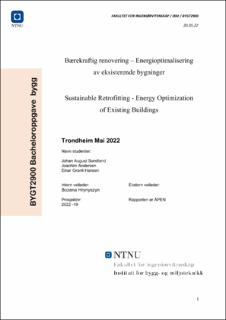| dc.description.abstract | På bakgrunn av nasjonale og internasjonale bærekrafts mål stilles det stadig strengere krav til bygningers energiforbruk og utslipp av klimagasser. Det meste av Norges bygningsmasse i 2050 eksisterer allerede i dag. En høyere renoveringstakt og økt kunnskap om løsninger, kan bidra til å senke energiforbruket, og er derfor et viktig bidrag for å nå målet om å bli et lav ut-slippsamfunn. Studier viser at renovering ofte er bærekraftig i seg selv da den miljømessige belastningen med å rive og bygge nytt er stort. SINTEF konkluderer på bakgrunn av livsløpsvurderinger, at renovering og gjenbruk av materialer ofte et bedre alternativ. Forskningssenteret for nullutslippsbygninger i smarte byer «FME ZEN» er en av aktørene som jobber med å utvikle løsninger for fremtidens bygninger og nabolag som kan bidra til å realisere nullutslippssamfunnet. Noen av ZEN konseptene og innovasjonene er derfor en del av denne oppgaven.
I denne oppgaven er det gjennomført en casestudie av høyblokkene, som er en del av bygningskomplekset Sentralbyggene på NTNU Gløshaugen i Trondheim. Målet med oppgaven er å kartlegge utfordringer og muligheter med bygget, og deretter legge frem forslag til tiltak som kan gjennomføres. Oppgaven begrenses til å se på hvilke tiltak som er mulig og hvilken effekt det har på byggets energiforbruk og CO2-utslipp. Kostnader og utslipp knyttet til renovering er ikke vurdert. Først legges det frem relevant teori om bærekraft, renovering og energiforbruk. Deretter er det med bakgrunn i gammelt prosjekteringsmateriell, blitt gjennomført en analyse og en energisimulering som viser dagens energiforbruk, og utslipp ved drift av bygget. Resultatene fra simuleringen sammenlignes med reelle tall for byggets energiforbruk. Til slutt legges det frem to ulike konsepter for renovering av høyblokkene, der effekten av tiltakene er målt med gjennomføring av nye energisimuleringer.
Konsept 1 er en energiambisiøs renovering med passivhuskomponenter, og benytter et Plug-and-play-fasadesystem. Tiltaket er preget av store isolasjonstykkelser og de tekniske anleggene byttes i stor grad ut med nye. Deler av fasadene kles inn med bygningsintegrerte solceller og det installeres et system basert på Li-ione batterier for lagring av overskuddsstrøm. Resultatene viser en drastisk nedgang i både energiforbruk og CO2-utslipp tilknyttet drift. Konsept 2 er et renoveringstiltak som sikter seg mot å rehabilitere eksisterende betong, tilfredsstille kravene i TEK17, og gi bygget et nytt arkitektonisk utrykk. I konseptet benyttes det TES-elementer som legger opp til en effektiv drift på byggeplass og sørger for å få lukket bygget hurtig. Større deler av det tekniske anlegget beholdes og ventilasjonskanaler gjenbrukes. | |
| dc.description.abstract | As a result of national and international sustainable development goals there are now stricter requirements regarding buildings energy consumption. Most of Norway’s building stock in 2050 already exists today, and to reach these goals there needs to be more retrofitting projects to decrease existing buildings energy usage. Studies has shown that retrofitting old buildings is a sustainable option, contrary to demolishing and building a new one. The research center for zero emission neighborhoods in smart cities (FME ZEN) are working on developing innovations that could reduce buildings energy consumption and the release of greenhouse gas emission.
In this thesis there has been conducted a case study of the two high rise buildings that is part of a building complex called Sentralbyggene at NTNU Gløshaugen in Trondheim. The goal was to analyze the existing buildings and to propose sustainable solutions, that could decrease the energy consumption of the buildings. This thesis focused only on sustainable solutions for retrofitting, and does not consider the cost of the retrofitting, or the CO2 emissions related to the retrofitting. Since the thesis used technical terminology and theory, it was therefore necessary to lay out the fundamentals for this. The second chapter was thus dedicated to explaining and clarify this theory, and to enlighten the reader and make it easier to understand the coherence later in the thesis.
By searching through old blueprints of Sentralbyggene, the construction method and the components used was clarified. The blueprints were thus the foundation for the analysis that was done in chapter 4. After this analysis there is suggested to different concepts for retrofitting these buildings. With the blueprints and documentation providing the basis for the solutions, it was important to explain how the content was handled and analyzed, and the method that was used during the analysis. The quantitative and qualitative method was used when working with the analysis, and the documentation was checked with the use of known reliable sources.
The two concepts suggested different solutions for technical systems like ventilation, heating and solar power, as well as constructional solutions. From an interview with a construction engineer and professor at NTNU, it was made clear that the concrete elements on the north, and south side of both buildings was in bad condition and needed to be removed [1]. After the removal of these elements, the concrete columns and concrete floor remains. These columns made a great foundation for the planning of the solutions since these could not be removed. The columns are load bearing, so the solution was designed to be built in between these columns.
The use of premade timber element system “TES”, and premade plug and play systems was suggested, since it could be easy to assemble in between the concrete columns. With the analysis of the old construction, and the new solutions, the energy simulation of the buildings started. These simulations granted us enough data and information to compare the energy budget of the old building, with the energy budget that was simulated with the new solutions implemented on the buildings. The results show a significant reduction in energy consumption and release of CO2 | |
